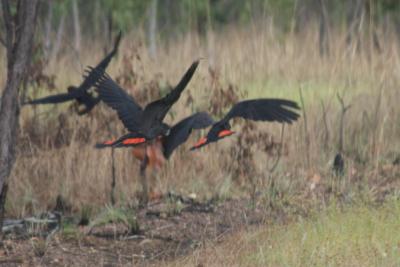For the Birds
 Monday, April 28, we departed Jabiru at 6:00 a.m. on the way to the Nourlangle site in Kakadu National Park. This site has two things we want to see, Aborigine rock art or petroglyphs and a scenic viewpoint overlooking that part of the park. Our early departure is an attempt to cope with the extreme humidity and very warm temperatures that are common in this part of Australia. We are just 13 degrees from the equator so every day is a warm day and there is plenty of moisture.
Monday, April 28, we departed Jabiru at 6:00 a.m. on the way to the Nourlangle site in Kakadu National Park. This site has two things we want to see, Aborigine rock art or petroglyphs and a scenic viewpoint overlooking that part of the park. Our early departure is an attempt to cope with the extreme humidity and very warm temperatures that are common in this part of Australia. We are just 13 degrees from the equator so every day is a warm day and there is plenty of moisture.
We got to the Mourlangle area just after 7:00 a.m. The area doesn’t officially open until 8:00 a.m. according to the sign at the entrance road but the gate was open so we continued to the site. The trail we chose took us to the viewpoint and then it continued to the petroglyphs and finally back to the parking lot. The trail to the viewpoint started level and paved but quickly turned into a steep rocky trail. Once at the viewpoint, we had spectacular views of the rugged dissected plateau that forms the southern part of the park. We spent time there enjoying the view as the sunrise lit the rocks that towered over us.
Continuing on the trail we descended into the rainforest along the base of a cliff. Water dripped from the top of the cliffs, the result of rain the night before. We stopped to sit on a bench for a while to listen to the water dripping from the cliffs and the babbling of the brook that resulted. While sitting there, Louise saw a bird and directed my attention to its perch. I quickly found the bird and described it to Louise. She found it in our Birds of Australia book and we then confirmed its identification. We were looking at an Emerald Dove, found only along the tropic coast of Australia. It was a beautiful dove and a lucky find. That bird made our day!
We left the bench and continued on the trail to the artwork we also wanted to see. The sites were along the base of the cliff protected from the weather by a large overhang. The first site was a startling array of artwork, a couple of dozen figures in varying degrees of sophistication from early primitive art to very elaborate drawings with good detail. The site had been occupied for 20,000 years and the artwork had accumulated over that time.
We continued on the trail and saw an amazing series of petroglyphs with interpretative information explaining the meanings of various figures in the drawings. We spent an hour going from one set of drawings to the next. By the time we returned to the parking lot it was 9:30 a.m. We planned to visit two other sites before the weather became too warm so we were off to the next site.
On the road we flushed a flock of Red-tailed Black Cockatoos. We had seen them fleetingly several days before when we flushed another flock but this time we went back to get a good look at them and snap a few pictures. When they take off they look like they could be a flock of big Ravens but their red tails catch your attention immediately. When they are sitting, their helmet-like crest and huge bills make them a really distinctive bird.
Our next stop was at Mamukala, a large wetlands area with a bird blind for observing the birds around the wetlands. When we arrived there was one other couple there. We immediately identified several pairs of ducks as not ducks but Green Pygmy-geese. They were the size of ducks but had the long necks of a goose. Another couple from Britain came in and mentioned several birds they had noticed outside the blind on the walkway to the blind. They helped identify several birds we were working to identify. We continued viewing the area from the blind. Several buses arrived and groups of people came through the blind in droves. We visited with several and shared views through my spotting scope with a few.
I won’t list all the birds we saw but we added at least half a dozen birds to our list of Australian birds we have seen on this trip. We also had some great chances to see other birds we had seen only once and not under the best observing conditions. A pair of Whistling Kites sat in a tree above the observing blind and whistled and squawked then flew circles overhead so we really got to see them well. We watched a pair of Rufous-banded Honeyeaters building their nest right outside the bird blind.
By this time we had spent so much time at the first two sites we had to cancel our plans to visit the third site. We debated staying for another day at Kakadu National Park to see the third site but instead chose to continue on to Darwin to keep our trip on its planned schedule.



0 Comments
Recommended Comments
There are no comments to display.
Please sign in to comment
You will be able to leave a comment after signing in
Sign In Now